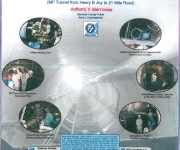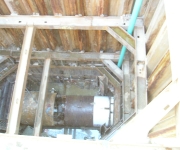Description: Construction of approximately 13,000 lineal feet of 66” inside diameter finished sewer. The Phase I Sewer receives flow at the northern end from both existing sewers and future project phases and outlets at the south end to the existing 11’ inside diameter Lakeshort Interceptor Sewer.
The sewer is designed as a 66” inside diameter conduit at a depth of generally 45’ to 50’ below the ground surface. Trenchless methods were chosen to install the sewer and major design and construction considerations included: idenfication of existing hardpan behavior during tunneling, boulders within the hardpan, required competent hardpan cover between the tunnel and overlying wet granular materials, dewatering requirements, and the resulting selection of tunneling methods. Use of concrete jack pipe methods combined with an open atmosphere tunnel boring machine was selected as the preferred method. The final project design consisted of ASTM C-76 Class V concrete pipe installed using jack pipe methods with a convential tunnel boring machine.
Two types of construction shafts were used on the project; mining shafts and intermediate manhole shafts both designed by Ric-Man. A rectangular steel sheet pile shaft was used for the initial mining shaft, and circular shaft geometry with corrugated metal pipe (CMP) supports were used for the remaining mining shafts.
The CMP supported mining shafts were excavated in multiple stages using augers. The upper stage utilized a combination of 20’ diameter horizontal steel ribs and vertical timber lagging for temporary earth support. The middle stage utilized an 18’ diameter CMP, and the lower stage utilized a 16’ diameter CMP for earth support. Some stages of the shaft were excavated in the wet and required placement of the concrete base slabs and annular grout by tremie methods. Others were able to be excavated to their design depths in open, dry excavations. The CMP supports were abandoned in place once mining operations were complete and the manholes were constructed.
Intermediate shafts were constructed using 8’ diameter temporary steel casing supports, and were excavated in multiple stages using augers. Some were excavated in the wet, while others were excavated to their design depths in open, dry excavations. Penetrations into the newly constructed sewer liner were accomplished using Ric-Man’s designed cast-in-place concrete “collars”. These collars were connected to the RCP sewer using reinforcing steel dowels installed in epoxy-grouted holes in the RCP. The dowels were then cast within reinforced concrete that supported the proposed opening in the sewer crown in addition to the proposed manhole risers.


